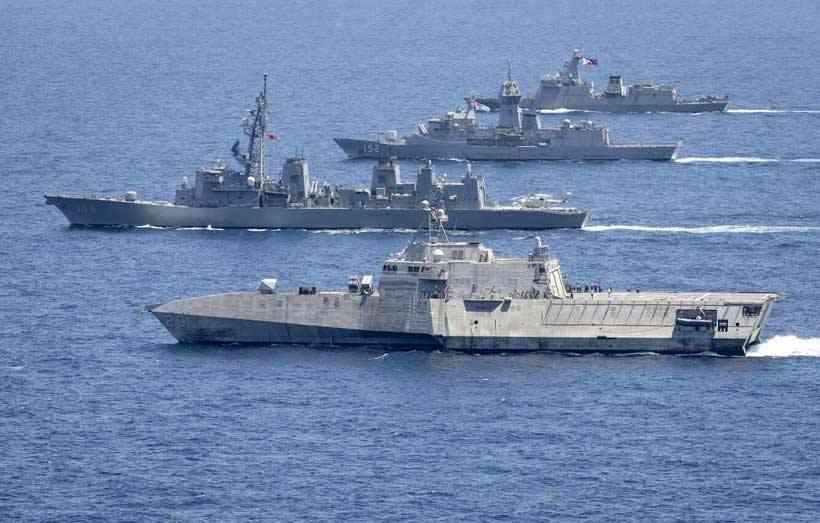
Foreign and security policy trajectories of Southeast Asian nations continue to revolve around a delicate balancing act—maintaining strategic autonomy while navigating the growing assertiveness of China and the unpredictable engagement of the US. This is becoming increasingly apparent in the South China Sea, where Beijing’s aggressive posture under President Xi Jinping has heightened regional anxiety and compelled recalibrations in Southeast Asian national defence policies.
Among ASEAN claimant countries in the South China Sea dispute, the Philippines has emerged as one of the most vocal in defending its maritime claims. Driven by disillusionment with ASEAN’s institutional paralysis and failure to fully implement even a non-binding Code of Conduct, Manila sought to internationalize the dispute and build robust security ties with like-minded partners. Its recent strategic engagements—including bilateral drills with Japan and expanded military cooperation with the U.S., Australia, France, and India—mark a deliberate pivot toward a multilateral deterrence architecture.
In May 2025, the second round of joint naval drills between the Philippines and Japan was conducted off the coast of Luzon, focusing on anti-submarine warfare and interoperability, the exercise also focused on simulated target tracking, coordinated detection, and helicopter operations. These exercises reflect Tokyo and Manila’s shared concern over China’s grey-zone tactics, such as the harassment of Filipino offshore vessels at Scarborough Shoal by Chinese maritime militias and coast guard units using water cannons—tactics designed to avoid outright conflict while gradually altering the status quo.
This alignment is a part of a broader shift in the Philippines’ strategic posture, reinforced by the 2025 Balikatan exercises, now among the most expansive U.S.-Philippine military collaborations to date. These exercises—featuring full-scale amphibious landings, integrated air-sea battle simulations, and operations across disputed waters—send a clear message: Manila is no longer willing to be a passive observer of Beijing’s encroachment.
These actions appear targeted at countering China’s ever-increasing grey zone tactics. Recent incidents, such as Chinese coast guard vessels using water cannons against Filipino fishing boats, underscore the increasingly contested and volatile nature of the maritime environment and the risks of further military escalation in the South China Sea.
China, unsurprisingly, views this evolving posture as a provocation. Chinese academics such as Zhuo Hua argue that the Philippines-Japan exercises represent a growing “military collusion” aimed at inflaming regional tensions and manufacturing a “China threat” narrative. Another assessment claims that the Japan–Philippines alignment is unlikely to endure, pointing to their divergent interests and irreconcilable priorities in the region.
Others, including Hu Xin from the China Institute of South China Sea Studies, accuse Manila of weaponizing international law through its 2016 arbitration case and deepening military ties with non-regional actors to sideline Beijing diplomatically. She argues that since the 2012 standoff over Huangyan Island, the Philippines has pursued a strategy of “internationalised legal warfare”, from initiating arbitral proceedings to opening additional bases to the U.S. military and conducting joint patrols with non-regional powers.
Yet these critiques ignore the deeper structural shifts shaping Manila’s strategic calculus. Two key realities stand out:
- Beijing seeks ASEAN support for dominance in South China Sea
- Renewed dynamism of Chinese economy a pivotal driving force for Asian recovery, integration
- China’s Myanmar playbook and its far-reaching regional implications
- The South China Sea: An Arena of Enduring Contestation
Keep Reading
- ASEAN’s Strategic Deficit: Despite being the most directly affected regional body, ASEAN has struggled to assert collective agency in the South China Sea. Internal divisions and consensus-based decision-making have rendered it ineffective in addressing China’s incremental assertiveness and in defending the maritime rights of its members. ASEAN has failed to recognise, prioritise and secure some of the member states’ maritime interests and mount a united or effective response to Chinese maritime assertiveness.
- Uncertainty of U.S. Commitment: While the Philippines is formally a US treaty ally, doubts about American reliability—especially under the second Trump administration—have intensified. Washington’s recent cancellation of a high-profile port call in Da Nang by the USS Nimitz carrier strike group due to the Iran-Israel crisis exemplifies its overstretched global posture. Washington’s recent decision to review the AUKUS submarine deal with Australia puts the US’ credibility in question prompting seasoned diplomats such as Gareth Evans to argue that Australia should not solely rely on the US anymore. Although symbolic military deployments continue, they no longer reassure regional partners as they once did.
These uncertainties are prompting a shift toward regional hedging and diversification. Manila is actively forging deeper ties with Japan, India, Australia, and the EU member states such as France, reflecting a growing consensus that regional security cannot rely solely on Washington’s commitment. Japan’s growing security role—through arms transfers, capacity building, and defence cooperation agreements—illustrates this emerging pattern of “minilateral” security frameworks.
This regional recalibration is not without risk. China’s grey-zone tactics continue unabated, and its naval modernization remains unmatched in the region. Without an effective counterbalance, Beijing may become emboldened to test the limits of regional resolve.
Nevertheless, the Philippines’ evolving strategy—backed by a broader coalition of like-minded Indo-Pacific partners—may be the beginning of a new security paradigm. One in which deterrence is decentralized, partnerships are diversified, and stability is maintained not through a single hegemon, but through a resilient network of regional actors committed to a rules-based order.
The question remains whether the US can adapt to this emerging reality. Failure to do so risks ceding strategic ground to China and hastening the erosion of American influence in the Indo-Pacific.







